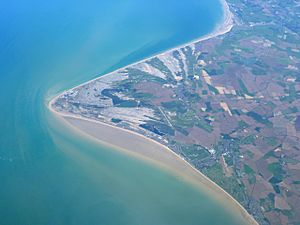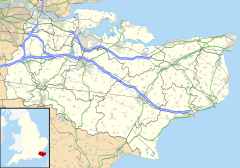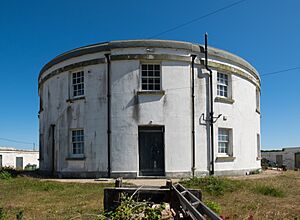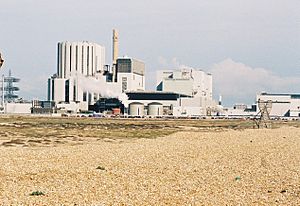Dungeness facts for kids
Quick facts for kids Dungeness |
|
|---|---|
 Aerial view of Dungeness |
|
| Area | 12 sq mi (31 km2) |
| OS grid reference | TR0917 |
| Civil parish | |
| District |
|
| Shire county | |
| Region | |
| Country | England |
| Sovereign state | United Kingdom |
| Post town | Romney Marsh |
| Postcode district | TN29 |
| Dialling code | 01797 |
| Police | Kent |
| Fire | Kent |
| Ambulance | South East Coast |
| EU Parliament | South East England |
| UK Parliament |
|
Dungeness is a special place on the coast of Kent, England. It's a type of landform called a headland, which means it's a piece of land that sticks out into the sea. Dungeness is mostly made up of a huge shingle beach, which is a beach covered in small, rounded stones instead of sand. This unique shape helps protect a large, low-lying area nearby called Romney Marsh.
Dungeness is home to a few important things: the Dungeness Nuclear Power Station, a small village also called Dungeness, and a very important wildlife area. It's all part of the local area known as Lydd.
Contents
What's in a Name?
The name Dungeness means "the headland at Denge." This refers to a nearby marsh called Denge Marsh. This marsh was first mentioned way back in the year 774! The name might mean "marsh of the pasture district" or "marsh with land that has been fertilized."
Nature and Wildlife
Amazing Wildlife
Dungeness has one of the biggest shingle beaches in all of Europe. It's super important for nature because of its unique landforms, the many different plants and insects that live there, and its amazing bird life. Because of this, it has special protection as a National Nature Reserve (NNR) and other important conservation areas.
There are over 600 different types of plants at Dungeness, which is a huge number! That's about one-third of all the plants found in Britain. It's also a fantastic place to find insects like moths, bees, beetles, and spiders. Many of these insects are very rare, and some can't be found anywhere else in Britain.
The old gravel pits on Denge Beach are now filled with water. Some have salty water, and some have fresh water. These watery areas are a safe haven for many birds that travel long distances or live near the coast. The RSPB (Royal Society for the Protection of Birds) has a bird reserve here, and many bird watchers visit every year to see the birds and the bird observatory.
One interesting spot is called "the patch" or "the boil." This is where warm water from the Dungeness nuclear power stations is pumped into the sea. This warm water helps sea life grow and attracts many seabirds from far away.
Fishing from the beach is also popular here, especially for cod in the winter.
You might have heard that Dungeness is the only desert in the UK because it gets so little rain. However, experts from the Met Office (the UK's weather service) said in 2015 that this isn't true.
Dungeness Weather
The weather in Dungeness is usually mild, which means it's not too hot or too cold. It also gets a fair amount of rain throughout the year. The average temperature each year is about 10.8°C (51.4°F). On average, it rains about 705 millimeters (27.8 inches) every year.
| Climate data for Dungeness weather station, 3m amsl (WMO identifier: 03888) 1991−2020 normals | |||||||||||||
|---|---|---|---|---|---|---|---|---|---|---|---|---|---|
| Month | Jan | Feb | Mar | Apr | May | Jun | Jul | Aug | Sep | Oct | Nov | Dec | Year |
| Mean daily maximum °C (°F) | 8.16 (46.69) |
8.25 (46.85) |
10.00 (50.00) |
12.46 (54.43) |
15.00 (59.00) |
17.81 (64.06) |
19.93 (67.87) |
20.30 (68.54) |
18.87 (65.97) |
15.57 (60.03) |
11.64 (52.95) |
8.81 (47.86) |
13.93 (57.07) |
| Mean daily minimum °C (°F) | 3.27 (37.89) |
3.18 (37.72) |
4.45 (40.01) |
6.29 (43.32) |
8.98 (48.16) |
11.74 (53.13) |
13.98 (57.16) |
14.36 (57.85) |
12.46 (54.43) |
9.82 (49.68) |
6.43 (43.57) |
3.76 (38.77) |
8.25 (46.85) |
| Average rainfall mm (inches) | 71.64 (2.82) |
48.87 (1.92) |
41.87 (1.65) |
51.92 (2.04) |
44.53 (1.75) |
46.08 (1.81) |
47.26 (1.86) |
56.61 (2.23) |
62.46 (2.46) |
80.08 (3.15) |
88.70 (3.49) |
74.96 (2.95) |
714.98 (28.15) |
| Average snowfall mm (inches) | 12 (0.5) |
9 (0.4) |
2 (0.1) |
0 (0) |
0 (0) |
0 (0) |
0 (0) |
0 (0) |
0 (0) |
0 (0) |
4 (0.2) |
12 (0.5) |
39 (1.7) |
| Average rainy days | 10.9 | 9.3 | 9.8 | 8.5 | 8.1 | 8.7 | 7.2 | 7.9 | 8.8 | 12.2 | 12.1 | 11.1 | 114.6 |
| Average snowy days | 2.5 | 2.9 | 0.8 | 0.1 | 0 | 0 | 0 | 0 | 0 | 0 | 0.4 | 1.3 | 8 |
| Average relative humidity (%) | 86 | 84 | 79 | 75 | 76 | 75 | 74 | 75 | 77 | 82 | 86 | 86 | 80 |
| Average dew point °C (°F) | 4 (39) |
4 (39) |
5 (41) |
7 (45) |
9 (48) |
12 (54) |
14 (57) |
14 (57) |
13 (55) |
11 (52) |
8 (46) |
5 (41) |
9 (48) |
| Mean daily sunshine hours | 4.1 | 3.8 | 6.0 | 8.9 | 8.6 | 9.0 | 9.1 | 9.3 | 8.1 | 4.7 | 3.9 | 4.3 | 6.7 |
| Source 1: Met Office | |||||||||||||
| Source 2: Time and Date (dewpoints, between 2005-2015) | |||||||||||||
Cool Buildings
Lighthouses: Guiding Ships
Dungeness has had many lighthouses over the years, seven in total! They help guide ships safely past the coast. At first, there was just a simple fire beacon. This was replaced by a wooden lighthouse in 1615, which was about 11 meters (35 feet) tall.
As the shingle beach grew, the sea moved further away. So, in 1635, a new, taller lighthouse called Lamplough's Tower was built closer to the water. It was around 34 meters (110 feet) high.
In 1792, another new lighthouse was built by Samuel Wyatt. This one was 35 meters (116 feet) tall. Later, it was painted black with a white band so ships could see it better during the day. This lighthouse was taken down in 1904, but the old homes where the lighthouse keepers lived are still there today.
Building the fourth lighthouse, the High Light Tower, started in 1901. It first shone its light on March 31, 1904. This lighthouse is still standing, but it's not used to guide ships anymore. Instead, you can visit it! It's a round brick building, 46 meters (150 feet) tall, and has 169 steps. From the top, you get an amazing view of the shingle beach.
Because the sea kept moving further away, and the new nuclear power station blocked the light from the 1904 lighthouse, a fifth lighthouse, called Dungeness Lighthouse, was built.
Power Stations: Making Electricity
There are two nuclear power stations at Dungeness, known as "A" and "B." The first one, "A," was built in 1965, and "B" was built in 1983. These power stations are located within a special wildlife area, and birds actually thrive in the warmer water that flows out from the stations.
The older power station ("A") stopped working on December 31, 2006. The company that owns the newer station ("B"), EDF Energy, announced in June 2021 that it would also stop making electricity. It is now being prepared for decommissioning.
There used to be a public visitor center and tours of the "B" station. After some time, a new visitor center opened in 2013, and tours started again. However, you need to arrange these tours weeks in advance because of security rules.
The Hamlet: A Unique Village
Besides the power stations and lighthouses, Dungeness has a small collection of homes. Many are wooden beach houses. There are also about 30 houses that were made from old railway coaches in the 1920s! These homes belong to fishermen whose boats are often right on the beach.
Closer to the main road, there's a large building that used to house coastguards. You can also find two pubs here: the Britannia and the Pilot. The Pilot Inn even had its own railway station for many years! You can buy fresh seafood from several places around the shingle beach.
One very famous house is Prospect Cottage. It used to belong to the artist and film director Derek Jarman. The cottage is painted black, and it has a poem written on one side. The garden is very unusual, made from pebbles, driftwood, scrap metal, and a few tough plants that can survive the windy weather.
Getting Around Dungeness
You can reach Dungeness by two roads. One comes along the coast from New Romney to the north, and the other comes from Lydd to the north-west. Both roads meet near the Pilot pub, and from there, a single road goes about 1.6 kilometers (1 mile) south to the very tip of Dungeness.
Dungeness also has a special, small railway called the Romney, Hythe and Dymchurch Railway. It's a miniature railway that runs for about 21.7 kilometers (13.5 miles) from Hythe. This railway opened to Dungeness in 1928 and is still a popular ride for tourists today.
There's a second, larger railway line here too, but it's only used now to carry waste from the power stations. It used to connect Dungeness to other towns, but it was closed to passengers in 1937.
Lydd Airport, sometimes called London Ashford Airport, is just north-west of Dungeness. Even though some people were against it because it's so close to the unique Dungeness landscape, the airport got permission in 2014 to make its runway longer. This means it can now handle bigger planes like a Boeing 737 or Airbus A319.
Military History
The beaches and marsh areas of Dungeness have been used for military training. You might see signs for "danger areas" there. During World War I, there was a military camp called Lydd Camp here.
Denge, an old Royal Air Force site, is home to some amazing concrete structures called "Listening Ears" or acoustic mirrors. These were built between 1928 and 1930 as an experiment to try and detect enemy aircraft by listening for their sounds. Denge was chosen because it was one of the quietest places in Britain. These "ears" weren't very effective and were stopped when radar was invented. Today, the Royal Society for the Protection of Birds manages the site.
In 1944, during World War II, some of the world's first underwater oil pipelines were laid between Dungeness and France. This secret project was called Operation Pluto. The pipelines from Dungeness were part of a network called "Dumbo" and went to Ambleteuse in France.
Dungeness Tudor Ship
In 2022, the well-preserved remains of a ship from the 1500s were found in Denge quarry at Dungeness. This was a very exciting discovery!
Dungeness in Media
Dungeness is a very popular spot for filming! You can often see it in music videos, on album covers, and in adverts.
- It was on the cover of Pink Floyd's 1981 album A Collection of Great Dance Songs.
- The British band The Soup Dragons filmed their music videos for "I'm Free" and "Mother Universe" here.
- The Lighthouse Family filmed parts of their "High" music video on the shingle beach.
- The "Listening Ears" are on the cover of the album Ether Song by Turin Brakes.
- The Prodigy's "Invaders Must Die" video was filmed here, showing both the acoustic mirrors and the lighthouse.
- Nicki Minaj's single "Freedom" was filmed on the beach with the acoustic mirrors.
- The music video for Ten Walls' "Walking With Elephants" was shot here, showing many of the famous landmarks.
Many bands have also written songs about Dungeness:
- Athlete has a song called "Dungeness" on their album Vehicles and Animals.
- Get Cape. Wear Cape. Fly mentions Dungeness and the lighthouse in his song "Lighthouse Keeper."
- The band November Coming Fire released an album called Dungeness in 2006.
On TV, Dungeness has been used as a backdrop for shows like the ITV drama The Poison Tree and an episode of The Inspector Lynley Mysteries. It was also featured in a special episode of EastEnders and in some Doctor Who episodes in the 1970s.
In movies, the "Time of Legends" scene in the 1981 fantasy film Time Bandits was filmed on the beach. Dungeness was also used for a scene in Danny Boyle's Trance.
Much of the 1998 film I Want You was set in Dungeness, with the main character living in one of the wooden beach huts. The 1990 film The Garden by Derek Jarman was also filmed and set in Dungeness.
Images for kids
See also
 In Spanish: Cabo Dungeness para niños
In Spanish: Cabo Dungeness para niños







